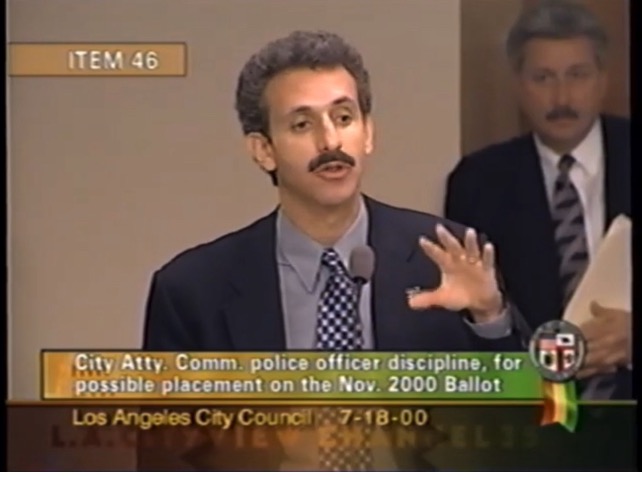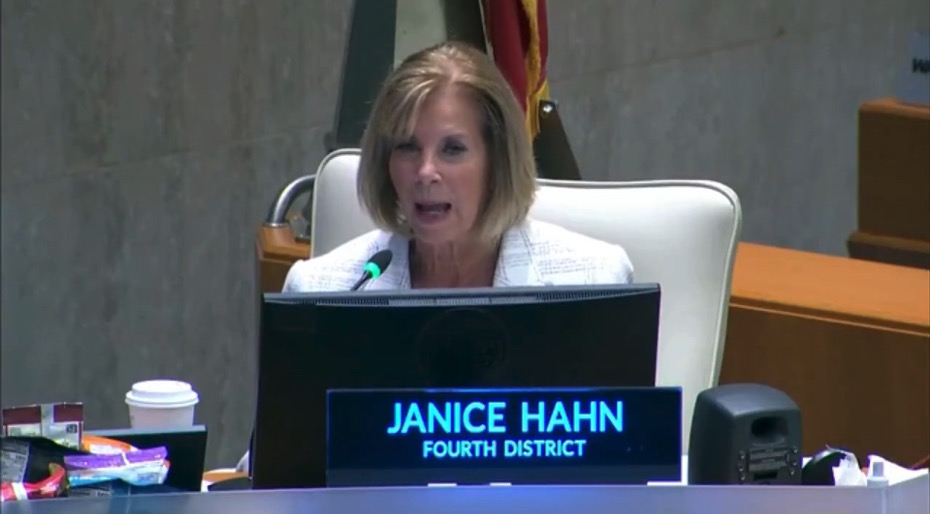Comments
ERIC PREVEN’S NOTEBOOK - Smart Speaker: Greetings, it’s Eric Preven from Studio City. I’d be there in person, but I’m on the call-in feature for accessibility.
Jonathan Groat, Deputy City Attorney: Sir, there is no call-in feature, as you know. First warning.
Smart Speaker: Arnie Berghoff reps Cisco’s Webex—talk about accessibility! (A loud beep sounds) That’s the Mcosker-o-Meter spiking, our weekly gauge of lobbyist clout.
Groat: Mr. Preven this is your second final warning.

Years ago, before Katy Yaroslavsky... there was Mike Feuer (CD5) will he be back?
Smart Speaker: Thank you, Groat. You’re losing it. Good morning, Council. your Friday Rule 18 in Van Nuys has goosed the Mcosker-o-Meter which is now pinned in the red. Tim McOsker—CD15 councilmember, ex-lobbyist, former city attorney—and his bubela Nella, head of Central City Association, rammed through last week’s $2.6 billion Convention Center deal, ignoring Katy Yaroslavsky and Nithya Raman’s budget warnings. Today, is a new day.
(A loud beep sounds)

Spin City, 2025.
Item 21: Hiring Ron Galperin—our ex-Controller—and Daniel Garrie as LA Alliance monitors, with no spending cap. Another blank check? Item 18: Lightstone/Marriott’s $100,000 to CD14’s fund—chump change next to downtown’s housing crisis. Item 12: A $116 million LAPD-Metro policing extension, bloating a fat security budget. Item 5: $15 million more for Oracle’s DWP contract. Oracle? That's Larry Ellison! Item 6: $22.57 million for McCrometer’s flow monitors, no General Fund hit, they swear.
And the kicker, Item 15: A misdemeanor for “space-saving parkers.” Not housing, not clean streets—just criminalizing parking hustle.
Cut the mic, Groat. The Smart Speaker has finished, and the people have a right to know.
Dial Tones and Strategic Silences
Tuesday’s Board of Supervisors meeting began with promise: a few weeks ago a shiny new Cisco Webex call-in system had been installed to replace the old AT&T line. The bloom came off the rose almost immediately this week. Callers were identified only by phone number, not name, and the system proved just as capable of dropping people as the last one. The message to the public was subtle but clear—you’re a number, not a neighbor.
The meeting itself was long and infuriating. After the invocation and pledge came a heritage parade that seemed to last as long as the probation hiring cycle. Immigrant tributes, a 44-year send-off for District Attorney Bea Dieringer, Eaton Fire heroics, and a multi-consulate reception turned the first two hours into a civic pageant. Applause breaks multiplied while, outside the room, the Los Angeles Times was reporting that County oversight agencies now need Executive Office approval for every press release and tweet. Control inside, control outside.
When the agenda finally began, the Board quickly punted a Malibu septic dispute to October 28, leaving the Dark Creek neighbors in suspense. Next was the County’s favorite oxymoron, “strategic vacancies.” Eight months to fill a single position is not strategy—it’s government at a glacial pace. I said so. Fourteen percent of jobs are empty, one-third of probation officers missing, clinics canceling appointments while residents wait and suffer. Other callers piled on with the same point: vacancies are prevention gaps, not clever management.
Then came the big-ticket item: the Lyons Canyon development in Santa Clarita—510 homes, a history of wildfire, and evacuation routes that amount to a hope and a prayer. Public speakers filled the room with hard truths: rooftops will never match the oxygen production of the old oaks slated for removal; AB 747 evacuation modeling assumes traffic magic; greenhouse gases don’t disappear because someone signs a Statement of Overriding Considerations. I listened to every word. That’s why I dial in.
Jonathan Groat, Deputy City Attorney: Once again we don't have dial in access.
Smart Speaker: Groat, first of all, you are not in this county board meeting and secondly, the city, your hole, needs to provide a call in option like the county or... I will continue.

The county's dual crises...fire victims and Immigration raids. (Mucho mas)
Anyway the quietest moment of the day: the much-anticipated parking-enforcement report. This was supposed to be the showdown between the Sheriff’s Department and Public Works. Instead we got a polite update that Public Works is slowly taking over unincorporated-area parking duties, tracking ticket revenue by ZIP code and experimenting with clearer signage. No officer counts, no ticket totals, no Sheriff vs. Public Works debate. Just a “receive and file” and on to the next item—a letdown made sharper by recent stories about expanding RV parking restrictions and Supervisor Holly Mitchell’s earlier motion to shift enforcement.
The sharpest public comments landed late in the afternoon. A mother described how her children were repeatedly sent back to an abusive father despite multiple police reports. Justice LA activists demanded the closure of Men’s Central Jail, reminding everyone that thirty-eight people have died in Sheriff’s custody this year, the most in two decades. Environmentalists kept up the pressure on Lyons Canyon, arguing that the County is inviting disaster by building dense housing in a Very High Fire Hazard Zone.
After more than four hours the Supervisors vanished into closed session for labor talks and anticipated litigation, emerging with the predictable coda: “no reportable action.” The county can grade 2.8 million cubic yards of hillside, plant 700 saplings, and phase in a new parking force, but it still can’t keep a phone line steady or trim a two-hour ceremony. Listening is free; it just takes will. Until the Board rightsizes its own indulgence, the public will keep speaking—one caller number at a time.
Towers and Powers
The County gambled on a cheap skyscraper during a down market, then balked at the true price of making it resilient. Now it’s sitting on the seismic findings, arguing over how much safety we can afford, while a well-documented structural vulnerability class hangs over the building type.
The 52-story Gas Co Tower—built in 1991 with brittle steel-moment connections never inspected after Northridge—was supposed to be the County’s shiny new headquarters. Consultants warned that a full retrofit would cost roughly $230 million, but the Board shelved the plan and sealed the seismic report. “Meets current code,” they say, as if code compliance means a 7.8 won’t red-tag the place.
So where do thousands of County employees go while the Supervisors dither? History gives a clue.
When the Hall of Administration needs work or a move stalls, the “temporary” solution is always the same: lease more Jamison space.
My nearly a decade old PRA spreadsheets show the County was cutting checks of about $1.6 million every month—nearly $19 million a year—to a lattice of Jamison-controlled LLCs: Metroplex, 350 Figueroa, 600 Commonwealth, Wilshire after Wilshire. Tenant-improvement reimbursements alone topped $22 million.
It’s a quiet empire and who knows how much it has expanded in ten years. The leases often list bland shell names until you flip to the signature page and see the same hand signing for all of them—a family operation whose current CEO, Harvard-Westlake and USC-bred Jaime Lee, sits on civic boards from USC’s trustees to city commissions.
So let’s ask the obvious: if the Gas Co gamble collapses—figuratively or literally—will the County simply funnel another wave of employees into Jamison towers, writing ever fatter checks to the same landlord it already feeds?
Or was that only a Mark Ridley-Thomas preferred provider?

No minnow left behind.
Release the seismic report. Make a decision. Because every month of delay is another month of rent checks to a private dynasty that doesn’t need the help.
Get the truth out. Or get out of the way.
Hint: Retrofit the Kenneth Hahn Hall of Administration building.
For a million reasons, not dollars, and out of deep respect for the great Gloria Molina Park.
Big Brother, Side Door
Dashiell Preven, 17, storms the stage, mashing “All Around the Mulberry Bush” into “She’ll Be Coming ’Round the Mountain.” Guitar slung like Keith Richards, he soaks in the room’s roar and deadpans to his dad: “Can we go now?”
Pure punk. Pure cool.
No laminate, just a last name and a camera. It got me into enough trouble. One night, mid-set at the Viper Room—my sister’s band Ednaswap tearing through “This Is a Song”—the door guys launched me onto Sunset Boulevard. I circled back, knocked, and said, “Wrong nuisance. I’m her brother.” Door swung open; same sweat, new perspective. I wasn’t the storyteller, just the story’s stubborn extra. Almost Famous: Family Edition.
The voice in the frame
In my stepsister Olivia Serafini-Sauli’s sharp documentary, "Endless Calls for Fame: The Story of the New Rising Sons" her off-camera breath during a band interview pulls her into the story, not just its keeper. It takes me back to Alek Keshishian filming my sister Anne lip-syncing an early tune into a fan, while wielding a clunky VHS camera with just enough gear and guts to capture the past. Gulp. Can’t look away. Have to.
The basement cathedral
Ann Arbor, 1980-something. The Halfass, a cinderblock chapel with a PA, hosted the Colorforms—too wild to tame—alongside Civilian Fun Group. A hundred kids learned proximity is a skill: close enough to feel it, far enough to see it. The East Quad Music Co-op ran the board, flyers bled Xerox ink, every chorus threatening to dislodge a ceiling tile. Love a song enough, it breathes; grip too tight, it bolts.
A band’s nothing without its peeps. “Fans” feels too soft for the diehards who caught Colorforms at the Halfass and still whisper “reunion?” Not likely. (Don’t quote me.)
The living-room A&R meeting
Fast-forward to Laurel Canyon living rooms, where Scotty—strategist and high priest of hustle—turned hangs into showcases. Paul Bushnell on bass. Rusty Anderson hitting the opening chords. Carla Azar counting off like a dare. Duncan Sheik adding cool. My job? Bring Roland, our Swiss photographer, and—Scotty’s genius—keep the room feeling like a room, not a test. When Sylvia Rhone walked in, the air shifted. She heard the monster and signed the band. Then, in true rock-and-roll fashion, they didn’t record that song that way.
Success isn’t just picking the right hills to die on; it’s choosing the songs you live with.
The van, the venues, the version
Ednaswap opening for Weezer.
Tell the legend how you want—beat-up vans, motels, people insisting you’re lucky for the grind—but L.A. was electric. Whisky a Go Go. Viper Room. Troubadour. Packed, sweaty, alive. Ednaswap, fronted by my sister, carried the grit of Ann Arbor’s basement days, now amplified. Their song “Torn” echoed everywhere, a melody bigger than their record sales. They opened for No Doubt, channeling Jane’s Addiction’s edge over pop coronation. The world learned “Torn” two ways: sung by a star, or written by Anne. (Howard Stern prefers her take. He’s got a point.)
The cone and the dog
Rusty once rocked a traffic cone as a hat during a West L.A. gig—performance art before call time—then went on to play with Paul McCartney nightly. Fans still dream of him revisiting Ednaswap. Meanwhile Nicki, the dog that never toured, could escape any gate. Band life’s secret? Be Rusty when the beat drops; be Nicky when the fence looks climbable.
Peeps, not pilgrims
I’ve stood in rooms—CBGB as a Mamaroneck High kid cheering the Student Teachers; the Halfass for Jonathan Richman; the Viper and Troubadour when the floor turned liquid. I’ve also stood outside, pleading with clipboard guys who’ve heard every story. Sometimes they let you in. Sometimes they do you a favor by not. This is personal: Anne co-wrote “Torn”; Olivia’s film captures the spark; I’m Dashiell’s uncle, watching him wield that same reckless fire. Scotty, tireless soul of the operation, taught us to live for the work—humble, relentless, chasing better. Grind till you drop, care till they call you crazy. No regrets, just the beat of a job well done.
The hook that holds
The Deftones still roar; Olivia’s film makes “almost” soar; the Colorforms flicker like a living rumor. “Torn” has strangers from L.A. to Tokyo humming Anne’s melody. None of it matches the jolt of being tossed out a side door and slipping back in before the chorus hits. I’m not with the band—I’m with the peeps who make it possible. The kid with the borrowed camera, the stepsister whose voice cuts through, the door guy who blinks and lets you slide. And you, humming the hook, kicking open a gate the dog’s already cleared. That’s the song. That’s the story. Keep singing it.
(Eric Preven is a Studio City-based television writer-producer, award-winning journalist, and longtime community activist. He is known for his sharp commentary on transparency and accountability in local government. Eric successfully brought and won two landmark open government cases in California, reinforcing the public’s right to know. A regular contributor to CityWatch, he combines investigative insight with grassroots advocacy to shine a light on civic issues across Los Angeles.)












